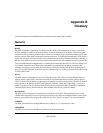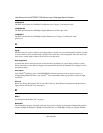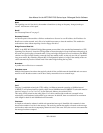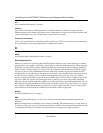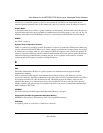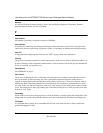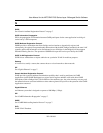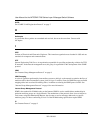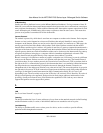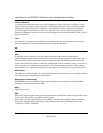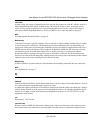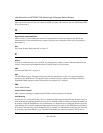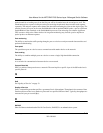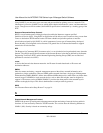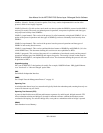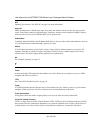
User Manual for the NETGEAR 7200 Series Layer 2 Managed Switch Software
Glossary B-9
202-10010-01
IP Multicasting
Sending out data to distributed servers on the MBone (Multicast Backbone). For large amounts of data, IP
Multicast is more efficient than normal Internet transmissions because the server can broadcast a message to
many recipients simultaneously. Unlike traditional Internet traffic that requires separate connections for each
source-destination pair, IP Multicasting allows many recipients to share the same source. This means that
just one set of packets is transmitted for all the destinations.
Internet Protocol
The method or protocol by which data is sent from one computer to another on the Internet. Each computer
(known as a host) on the Internet has at least one IP address that uniquely identifies it among all other
computers on the Internet. When you send or receive data (for example, an e-mail note or a Web page), the
message gets divided into little chunks called packets. Each of these packets contains both the sender's
Internet address and the receiver's address. Any packet is sent first to a gateway computer that understands a
small part of the Internet. The gateway computer reads the destination address and forwards the packet to an
adjacent gateway that in turn reads the destination address and so forth across the Internet until one gateway
recognizes the packet as belonging to a computer within its immediate neighborhood or domain. That
gateway then forwards the packet directly to the computer whose address is specified.
Because a message is divided into a number of packets, each packet can, if necessary, be sent by a different
route across the Internet. Packets can arrive in a different order than they were sent. The Internet Protocol
just delivers them. It's up to another protocol, the Transmission Control Protocol (TCP) to put them back in
the right order. IP is a connectionless protocol, which means that there is no continuing connection between
the end points that are communicating. Each packet that travels through the Internet is treated as an
independent unit of data without any relation to any other unit of data. (The reason the packets do get put in
the right order is because of TCP, the connection-oriented protocol that keeps track of the packet sequence in
a message.) In the Open Systems Interconnection (OSI) communication model, IP is in Layer 3, the
Networking Layer. The most widely used version of IP today is IP version 4 (IPv4). However, IP version 6
(IPv6) is also beginning to be supported. IPv6 provides for much longer addresses and therefore for the
possibility of many more Internet users. IPv6 includes the capabilities of IPv4 and any server that can
support IPv6 packets can also support IPv4 packets.
L
LAN
See “Local Area Network” on page 10.
Learning
The bridge examines the Layer 2 source addresses of every frame on the attached networks (called listening)
and then maintains a table, or cache, of which MAC addresses are attached to each of its ports.
Load balancing
The ability to distribute traffic across various ports of a device, such as a switch, to provide efficient,
optimized traffic throughout the network.



